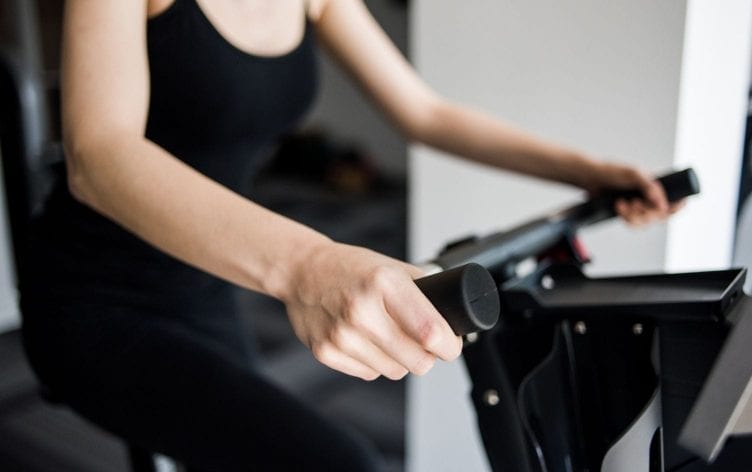
No matter your reason, deciding to start exercising is always a good idea. Exercise helps strengthen and protect the heart, strengthen bones and muscles, control weight, boost mood and increase energy. But, if you’re starting from scratch, it can be a daunting task. Fortunately, there are numerous resources to help you get up and moving, from personal trainers to sites like this one. By forming a game plan and applying best practices, you’ll be more likely to stick with it and keep going.
1
START SLOW
Before you hit the track, hop on a treadmill or enroll in a cardio class, you may want to talk to your doctor, especially if you’re new to exercise or it’s been a long time since you last worked out. It’s important to understand how exercise can impact certain health conditions and to gauge whether you may have limitations to work around. Once you’re ready to go, introduce exercise gradually.
“This point can’t be stressed enough,” says Mecayla Froerer, the director of training at iFit, an interactive fitness platform that offers workouts for treadmills, bikes, ellipticals and other equipment. “One of the biggest reasons why individuals fail to adhere to an exercise program is because they started off too hard or too fast. Listen to your body and challenge yourself just a little at a time.” Soreness is usually OK, but pain is your cue to stop what you’re doing immediately. “Pushing through too much discomfort to the point of pain will only lead to injury, thus inhibiting your ability to consistently exercise,” she adds.
You may want to enlist a trainer to show you the ropes. Exercise can be intimidating if you don’t know where to start. A qualified trainer can introduce you to equipment, demonstrate proper form and field all your questions.
2
WARM UP AND COOL DOWN
Once you’re ready to begin, it’s tempting to jump right in. But take a few minutes to get loose. “Warming up increases blood flow to the muscles and prepares them for the work they’ll undergo,” says Froerer. Warmups may look different depending on what you plan to do, but dynamic stretching and light cardio are always a good starting point. For example, if you’re going for a jog, begin by walking at an easy pace. If you are cycling, spend 5–10 minutes pedaling at a light resistance and easy cadence to warm up your legs.
When you’ve completed your workout, it’s time to cool down by lowering the intensity of your workout. “Feel your heart rate slowly decline, catch your breath, and then perform some static stretching to wrap things up,” says Froerer. Your muscles will thank you for the extra attention. “Stretching helps to relieve muscle tension, improve flexibility and range of motion, and will prevent muscle overcompensation and stiffness,” she adds. “When you’re limber, and the muscles are at ease, you will be able to perform at a higher level and maximize your results.”
3
SET A SCHEDULE
According to the Physical Activity Guidelines for Americans, healthy adults should do at least 150 minutes of moderate-intensity exercise or 75 minutes of vigorous-intensity exercise each week or an equivalent combination of the two. Ideally, activity should be spread throughout the week, and somewhere in that ambitious new schedule should be a couple of days of rest.
“Rest days are an essential component of any exercise routine,” says Froerer. “If you are going to be engaging in longer or harder workouts a few times each week, take a day in between each of those workouts to participate in active recoveries.” Rather than sitting on the couch all day to recover, try doing a short walk or bike ride, stretching or even meditating. “Whatever you decide to do, letting your body wind down from the grind of exercise will help you to push harder through your workouts and achieve maximum results.”
4
STICK WITH IT
You may have some ups and downs throughout the process, but try not to let discouragement get in your way of finding success. Remember why you began this journey, and let that be your driving factor in making exercise a priority in your everyday life, now and as you move forward.
“Consistency is the key factor in finding success in any exercise program,” says Froerer. “Weight loss, strength and body compositions won’t change overnight. Establishing a routine that is realistic will be vital in helping your body to consistently undergo positive transformations.”
SAMPLE CARDIO WORKOUT
Below, Froerer provides a sample workout that can be customized to whatever activity you want to do, whether it’s jogging or cycling outdoors or using a cardio machine at the gym. “Pushes should feel challenging, but you should still be able to hold a conversation without becoming breathless,” she says. “Recovery intervals allow you to go as slow as needed in order to catch your breath and let your heart rate come down slightly before moving your way to the next push.” Based on how you feel during the pushes, feel free to increase the intensity by upping the speed or resistance.
MODERATE INTENSITY CARDIO WORKOUT (35–45 minutes)
WARMUP (5–10 minutes)
- Dynamic stretches. Use a chair, wall or piece of equipment for extra support.
- Light-intensity cardio of the same type of exercise you plan to engage in — for example: a brisk walk, light jog, light cadence on the bike or elliptical.
WORKOUT INTERVALS (27 minutes)
- 1-minute push/1-minute recovery
- 2-minute push/1-minute recovery
- 3-minute push/1-minute recovery
- Repeat 3 times
COOL DOWN (5–10 minutes)
End your workout by slowing your pace and allowing your heart rate to come down for a few minutes. Then, try some static stretching to loosen up the muscles that have been worked. Good muscles to stretch after a typical cardio workout include the hamstrings, glutes, quads, calves and shoulders.
Check out “Workout Routines” in the MyFitnessPal app to discover and log workouts or build your own with exercises that fit your goals.



